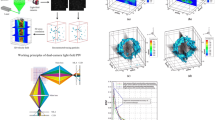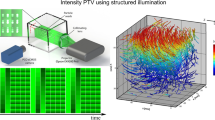Abstract
The study developed a triple-exposure color particle image velocimetry (TE-CPIV) technique associated with pressure reconstruction, and validated its feasibility. A light source with the three primary colors of red, green, and blue (R, G, and B) is produced in a time sequence by a liquid crystal display (LCD) projector. Particle images at three different instants under the color illuminations are captured in one snapshot using a color digital single-lens reflex (SLR) camera with a complementary metal-oxide semiconductor (CMOS) sensor. A contamination correction algorithm based on a specific calibration is performed on the different color layers (R layer, G layer, and B layer) of the raw color image to reduce the contaminated intensity of each color illumination on the other two color layers. The corrected intensity generates three new color layers, from which a standard cross-correlation process in the classical PIV method is used to obtain two velocity fields. Eventually, an instantaneous pressure field is reconstructed from the two velocity fields. The feasibility of TE-CPIV was tested by two experiments with a solid body rotation flow and a cylinder wake flow. The results show acceptable accuracy and robustness of the new technique. The idea of the TE-CPIV is believed to provide a simple and effective way of estimating a pressure field with low cost and high convenience.
Similar content being viewed by others
References
Van Oudheusden B W. PIV-based pressure measurement. Meas Sci Tech, 2013, 24: 390–392
Sridhar G, Katz J. Drag and lift forces on microscopic bubbles entrained by a vortex. Phys Fluids, 1995, 7: 389–399
Chang K. A multi-pulsed PTV technique for acceleration measurement. In: Proceedings of International Workshop on PIV’99-Santa Barbara, 3rd. Santa Barbara, 1999
Liu X, Katz J. Instantaneous pressure and material acceleration measurements using a four-exposure PIV system. Exp Fluids, 2006, 41: 227–240
Jaw S Y, Sheen J J, Hwang R. Development and application of an alternating-color micro-PIV system. In: Proceedings of ASME 2014 International Mechanical Engineering Congress and Exposition, IMECE 2014. American Society of Mechanical Engineers (ASME), 2014
Charonko J J, Antoine E, Vlachos P P. Multispectral processing for color particle image velocimetry. Microfluid Nanofluid, 2014, 17: 729–743
McGregor T J, Spence D J, Coutts D W. Laser-based volumetric colour-coded three-dimensional particle velocimetry. Opt Lasers Eng, 2007, 45: 882–889
McGregor T J, Spence D J, Coutts D W. Laser-based volumetric flow visualization by digital color imaging of a spectrally coded volume. Rev Sci Instrum, 2008, 79: 013710
Ruck B. Colour-coded tomography in fluid mechanics. Opt Lasers Eng, 2011, 43: 375–380
Cenedese A, Paglialunga A. A new technique for the determination of the third velocity component with PIV. Exp Fluids, 1989, 8: 228–230
Pick S, Lehmann F O. Stereoscopic PIV on multiple color-coded light sheets and its application to axial flow in flapping robotic insect wings. Exp Fluids, 2009, 47: 1009–1023
Brücker C. 3-D PIV via spatial correlation in a color-coded light-sheet. Exp Fluids, 1996, 21: 312–314
Murai Y, Yumoto T, Oishi Y, et al. Color tomographic PIV improved by removal of color contamination. In: Proceedings of 10th International Symposium on Particle Image Velocimetry. Delft, Delft University of Technology, Faculty of Mechanical, Maritime and Materials Engineering, and Faculty of Aerospace Engineering, 2013
Cenedese A, Romano G P. Comparison between classical and three-color PIV in a wake flow. J Flow Visual Image Process, 1993, 1: 371–384
Funatani S, Takeda T, Toriyama K. High-resolution three-color PIV technique using a digital SLR camera. J Flow Visual Image Process, 2013, 20: 35–45
Jaw S Y, Hwang R R, Shyu K L. Development and application of LED illumination color PIV. In: Proceedings of 2006 ASME Joint US-European Fluids Engineering Division Summer Meeting. Miami, 2006
Jaw S Y, Wu J L. Alternating color image anemometry and its application. J Flow Visual Image Process, 2000, 7: 189–205
McPhail M J, Fontaine A A, Krane M H, et al. Correcting for color crosstalk and chromatic aberration in multicolor particle shadow velocimetry. Meas Sci Tech, 2015, 26: 25302
McGregor T, Jeffries B, Spence D, et al. Three dimensional particle image velocimetry using colour coded light sheets. In: Proceedings of Fourth Australian Conference on Laser Diagnostics in Fluid Mechanics and Combustion. The University of Adelaide, South Australia, 2005
Borowsky J, Wei T. Simultaneous velocimetry/accelerometry measurements in a turbulent two-phase pipe flow. Exp Fluids, 2006, 41: 13–20
Dong P, Hsu T Y, Atsavapranee P, et al. Digital particle image accelerometry. Exp Fluids, 2001, 30: 626–632
Greated C, Skyner D, Bruce T. Particle image velocimetry (PIV) in the coastal engineering laboratory. Coastal Eng Proc, 1992, 1: 212–225
Hirakawa K, Wolfe P J. Spatio-spectral color filter array design for optimal image recovery. IEEE Trans Image Process, 2008, 17: 1876–1890
Chen T. A study of spatial color interpolation algorithms for single-detector digital cameras. Information System Laboratory Department of Electrical Engineering, Stanford University, 1999
Raffel M, Willert C E, Kompenhans J. Particle Image Velocimetry: A Practical Guide. Berlin Heidelberg: Springer, 2013
Koschatzky V, Moore P, Westerweel J, et al. High speed PIV applied to aerodynamic noise investigation. Exp Fluids, 2011, 50: 863–876
Thomas F O, Liu X. An experimental investigation of symmetric and asymmetric turbulent wake development in pressure gradient. Phys Fluids, 2004, 16 1725–1745
Van Oudheusden B W, Scarano F, Roosenboom E W M, et al. Evaluation of integral forces and pressure fields from planar velocimetry data for incompressible and compressible flows. Exp Fluids, 2007, 43: 153–162
Christensen K T, Adrian R J. Measurement of instantaneous Eulerian acceleration fields by particle image accelerometry: Method and accuracy. Exp Fluids, 2002, 33: 759–769
De Kat R, van Oudheusden B W. Instantaneous planar pressure determination from PIV in turbulent flow. Exp Fluids, 2012, 52: 1089–1106
Violato D, Moore P, Scarano F. Lagrangian and Eulerian pressure field evaluation of rod-airfoil flow from time-resolved tomographic PIV. Exp Fluids, 2011, 50: 1057–1070
Wang Z, Gao Q, Wang C, et al. An irrotation correction on pressure gradient and orthogonal-path integration for PIV-based pressure reconstruction. Exp J Fluids, 2016, 57: 1–16
Scarano F. Iterative image deformation methods in PIV. Meas Sci Tech, 2002, 13: R1
Prasad A, Adrian R, Landreth C, et al. Effect of resolution on the speed and accuracy of particle image velocimetry interrogation. Exp Fluids, 1992, 13: 105–116
Halvorsen K. Bias compensated least squares estimate of the center of rotation. J Biomech, 2003, 36: 999–1008
McKenna S, McGillis W. Performance of digital image velocimetry processing techniques. Exp Fluids, 2002, 32: 106–115
Huang H, Dabiri D, Gharib M. On errors of digital particle image velocimetry. Meas Sci Tech, 1997, 8: 1427
Gui L, Wereley S. A correlation-based continuous window-shift technique to reduce the peak-locking effect in digital PIV image evaluation. Exp Fluids, 2002, 32: 506–517
Garcia D. A fast all-in-one method for automated post-processing of PIV data. Exp Fluids, 2011, 50: 1247–1259
Wang C, Gao Q, Wei R, et al. Divergence-free smoothing for 3D-3C PIV data. In: Proceedings of 4th International Conference on Experimental Fluid Mechanics. Beijing, 2014
Pan C, Wang H, Wang J. Phase identification of quasi-periodic flow measured by particle image velocimetry with a low sampling rate. Meas Sci Tech, 2013, 24: 055305
Berkooz G, Holmes P, Lumley J L. The proper orthogonal decomposition in the analysis of turbulent flows. Ann Rev Fluid Mech, 1993, 25: 539–575
Stucky M J, Nino E, Gajdeczko B, et al. Two-color particle image velocimetry technique for an internal combustion engine. Exp Therm Fluid Sci, 1994, 8: 305–314
Bendicks C, Tarlet D, Roloff C, et al. Improved 3-D particle tracking velocimetry with colored particles. J Signal Inf Proc, 2011, 2: 59–71
Watamura T, Tasaka Y, Murai Y. LCD-projector-based 3D color PTV. Exp Therm Fluid Sci, 2013, 47: 68–80
Author information
Authors and Affiliations
Corresponding author
Rights and permissions
About this article
Cite this article
Wang, Z., Gao, Q. & Wang, J. A triple-exposure color PIV technique for pressure reconstruction. Sci. China Technol. Sci. 60, 1–15 (2017). https://doi.org/10.1007/s11431-016-0270-x
Received:
Accepted:
Published:
Issue Date:
DOI: https://doi.org/10.1007/s11431-016-0270-x




